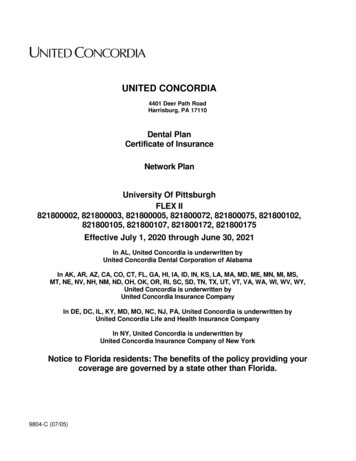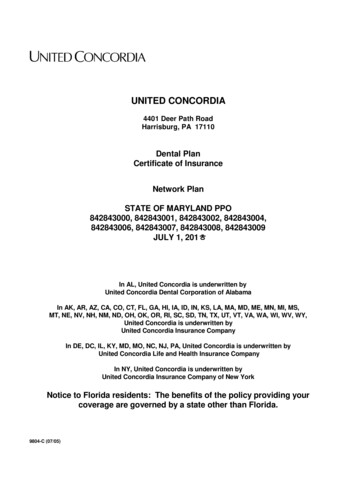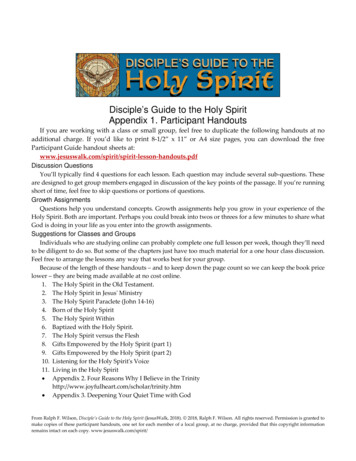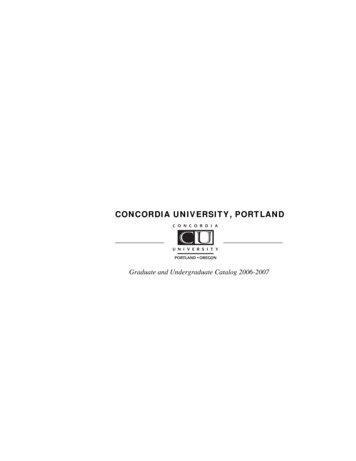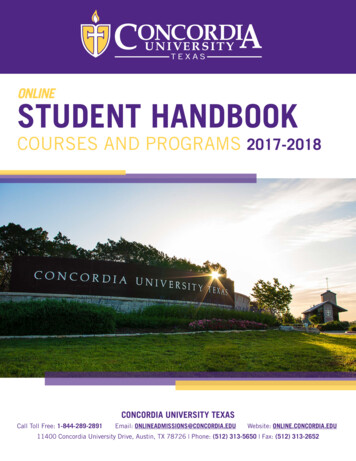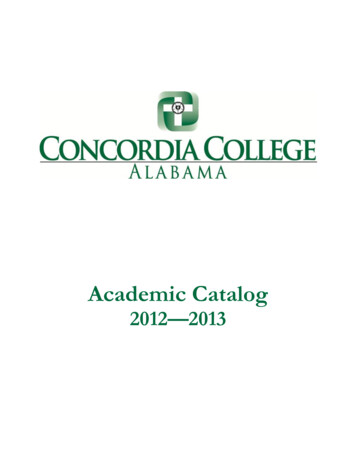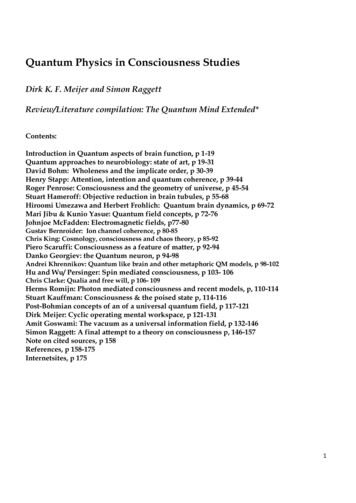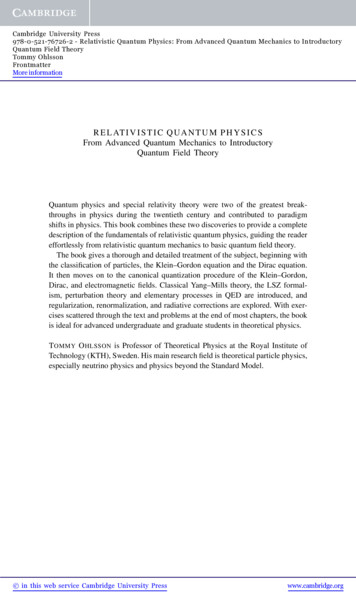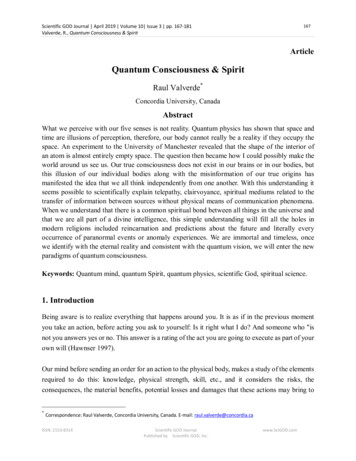
Transcription
Scientific GOD Journal April 2019 Volume 10 Issue 3 pp. 167-181Valverde, R., Quantum Consciousness & Spirit167ArticleQuantum Consciousness & SpiritRaul Valverde*Concordia University, CanadaAbstractWhat we perceive with our five senses is not reality. Quantum physics has shown that space andtime are illusions of perception, therefore, our body cannot really be a reality if they occupy thespace. An experiment to the University of Manchester revealed that the shape of the interior ofan atom is almost entirely empty space. The question then became how I could possibly make theworld around us see us. Our true consciousness does not exist in our brains or in our bodies, butthis illusion of our individual bodies along with the misinformation of our true origins hasmanifested the idea that we all think independently from one another. With this understanding itseems possible to scientifically explain telepathy, clairvoyance, spiritual mediums related to thetransfer of information between sources without physical means of communication phenomena.When we understand that there is a common spiritual bond between all things in the universe andthat we are all part of a divine intelligence, this simple understanding will fill all the holes inmodern religions included reincarnation and predictions about the future and literally everyoccurrence of paranormal events or anomaly experiences. We are immortal and timeless, oncewe identify with the eternal reality and consistent with the quantum vision, we will enter the newparadigms of quantum consciousness.Keywords: Quantum mind, quantum Spirit, quantum physics, scientific God, spiritual science.1. IntroductionBeing aware is to realize everything that happens around you. It is as if in the previous momentyou take an action, before acting you ask to yourself: Is it right what I do? And someone who "isnot you answers yes or no. This answer is a rating of the act you are going to execute as part of yourown will (Hawnser 1997).Our mind before sending an order for an action to the physical body, makes a study of the elementsrequired to do this: knowledge, physical strength, skill, etc., and it considers the risks, theconsequences, the material benefits, potential losses and damages that these actions may bring to*Correspondence: Raul Valverde, Concordia University, Canada. E-mail: raul.valverde@concordia.caISSN: 2153-831XScientific GOD JournalPublished by Scientific GOD, Inc.www.SciGOD.com
Scientific GOD Journal April 2019 Volume 10 Issue 3 pp. 167-181Valverde, R., Quantum Consciousness & Spirit168you or third parties (Hawnser 1997).The spirit of every human being acts contacting his physical being through his or her mind, whichacts with consciousness. The physical brain is a computer with its data warehouse. The mind is theresult of energy which acts to drive the operation of synchronizing the mental spheres, which arethe areas of energy that influence at different levels of consciousness. The energy manifests itselfin different ways to transform the same energy into vibration changes and depending on thecharacteristics of the vibration is the representation of that energy. The perception of the humanenergy depends on the direction through which one can capture the vibration that it has now(Hawnser 1997).Most western scientists assume that consciousness is produced in some form by the brain. There isof course evidence for that position. There is evidence of common sense in our daily lives. When aperson drinks too much alcohol or suffers a hard hit to the head, that person does not think clearly.We also have more sophisticated tests of the relationship between the brain and consciousness. Infact, all the theories of consciousness during the last century has been supported by psychologistswho have been moving toward materialism that characterized the nineteenth-century physicsbased on Newton's classical mechanics. These have been trying to show that consciousness is onlythe functioning of the physical brain. This materialistic psychology was supported by John Watson(1916), who wrote that psychology is a purely objective experimental branch of science that needsno consciousness in the same way that science does not need chemistry and physics. It is ironic thatwhile Watson linked psychology to classical physical knowledge of Newtonian physics this tonon-materialistic faced overwhelming experimental evidence that the universe is related toquantum physics that could not be made without reference to consciousness.Consciousness can be defined consciousness as the set of subjective, immediate or remoteknowledge that each being has about the world and himself. There are three main schools thatexplain consciousness: Neuroscientist, Quantum and Skeptic.2. School NeuroscientistObviously, proponents of this school advocate that consciousness arises from an activityneuronal merely more or less complex, and thus resides in the brain. This is the toughest schoolin their criticism of the others, which sometimes does not hesitate to ridicule because they areconsidered unscientific and too uncritical. Despite their sharp historical background, this is a realfashion. Its main champion is Francis Crick (Crick & Koch 2003) that has been dedicated the lastISSN: 2153-831XScientific GOD JournalPublished by Scientific GOD, Inc.www.SciGOD.com
Scientific GOD Journal April 2019 Volume 10 Issue 3 pp. 167-181Valverde, R., Quantum Consciousness & Spirit169twenty years to neurology. Its basic principle claims that before treating consciousness assomething mysterious and spurious, we must investigate under strictly scientific premises. If wedeclare the brain as an organ of unknown structure and possibly irrelevant, we never get to studyand thus meet its root functions regarding consciousness. Crick and Koch (2003) propose athorough study of neurons and their interactions that would pinpoint scientific models ofconsciousness, image of what happened with the transmission of genetic information throughDNA. To do this, Crick and Koch have focused their studies on the system visual uptake inhumans, since it is the best known and whose mapping neuronal is more clarified. If you couldcome to establish mechanisms of neurological type of consciousness to see, perhaps it wouldgive rise to continue other more complex as self-awareness. The problem is that if "beingconscious of one self" is a phenomenon od only humans, which does not occur in animals as nowit seems, the complexity of studies could be practically be an insolvable matter.M. Edelman (1993), holds that our sense of consciousness arises from what he calls "neuralDarwinism" that would not be but maintaining a close fight together of large groups of neuronsto configure a representation of the world. However, neither Francis Crick himself has been freeof similar criticism, as has been the case Gerald D. Fischbach (2002), a professor at HarvardUniversity and president of the Society Neuroscience, who has made no secret of his view thatthe proposed Crick’s theory regarding an "electrophysiological” explanation of consciousnesslacks enough scientific rigor. Tomaso Poggio (Koch et al 1983) from the Massachusetts Instituteof Technology, believes Crick’s theory is giving undue prominence to the intraneuronalexcitations which could explain a visual scene, to the detriment of other capabilities of the brainas its plasticity and ability to change network connections that may be created by this last systemstate of human consciousness.Also, within neuroscience school, another researcher, Antonio R. Damasio (1989) of theUniversity of Iowa, disagrees with Crick in the sense that if a comprehensive theory ofconsciousness should include how to acquire the sense of our selves, it should not only considerthe brain, but the whole body. Moreover, he is also convinced of something that otherwise seemsobvious: consciousness is also molded along the life of a human being by interactions betweenhim and his physical and social environment, so a model of simply neuronal consciousness isdoomed to failure if not considered other social forms of knowledge and theories.Christof Koch (Koch & Crick 1994), defends the thesis of the neuronal scheme of consciousnessISSN: 2153-831XScientific GOD JournalPublished by Scientific GOD, Inc.www.SciGOD.com
Scientific GOD Journal April 2019 Volume 10 Issue 3 pp. 167-181Valverde, R., Quantum Consciousness & Spirit170based on experiments with animals, mainly with anesthetized cats. These experiments speak of acertain neuronal synchronization in acts of perception and sensitivity but have the huge problemof the place of "assembly". He briefly explains this point referring to the typical Christmas treedecorated with many little bulbs of different colors. In an ambiguous situation observation, suchas a landscape, the neurons would be the bulbs going on and off for no apparent order,chaotically. However, when there is a perception, such as vision of a known face, it happens thata group of light bulbs go on in unison (synchronicity) and in a certain specific area (location), itdraws attention of the "neuronal group" on the perception received. The problem is that, by onehand, reason is unknown why certain group of neurons coordinate and no others, and on theother hand there seems to be a unique place to decide how to coordinate neurons and even howoften they should be.Other lines of criticism of current neuroscience, even within their own breast, they are those heldby Walter J. Freeman and Benjamin Libet that believe that this is nothing but a piece of thepuzzle of consciousness and "the current wave of enthusiasm about it is out of place" (Libet,Freeman& Sutherland 2000).3. Quantum SchoolThe trend to explain consciousness by applying quantum theories has gained popularity in recentyears and, although clearly disdained by neuroscientists, more and more researchers direct theirsteps this way up. Brian D. Josephson (1962) of the University of Cambridge, winner of the 1973Nobel Prize in Physics for his studies on the quantum effects in superconductors (Josephsoneffect), proposes a unified field theory, quantum nature, that would explain not only theconsciousness and its attributes, but also all the phenomenology observed to date in terms ofparapsychological and mystical experiences.What we can perceive with our five senses is not reality. Quantum physics has shown that spaceand time are illusions of perception. Our body cannot really be a reality if it does not occupy mostof the space it seems to occupy; an experiment made at the University of Manchester revealed theshape of the interior of an atom is almost entirely empty space. The question then became how wecould possibly make the world around us see us if this is the case (Russell et al., 1993).Our true consciousness does not exist in our brains or in our bodies, but this illusion of ourindividual bodies along with the misinformation of our true origins has manifested the idea that weall think independently from one another. With this understanding, it seems possible toscientifically explain telepathy, clairvoyance, spiritual mediums related to the transfer ofISSN: 2153-831XScientific GOD JournalPublished by Scientific GOD, Inc.www.SciGOD.com
Scientific GOD Journal April 2019 Volume 10 Issue 3 pp. 167-181Valverde, R., Quantum Consciousness & Spirit171information between sources without physical means of communication phenomena. But when weunderstand that there is a common spiritual bond between all things in the universe and that we areall part of a divine intelligence, this simple understanding fills all the holes in modern religions andpredictions about the future and literally every occurrence of events (Russell et al., 1993).According to quantum physics, the physical world and its reality, it's just a recreation of theobserved. We created the body and reality, as we create the experience of our world in its differentmanifestations dimensional. In its essential state (atomic or cosmic subquantum micro), the bodyis made of energy and information, not solid matter, this is only a meager level of perception.According to Tornell (2001), this is energy and information arising from the endless fields ofenergy and information spanning the entire universal creation.Another character that has stood in defense of a theory quantum of consciousness was the physicistRoger Penrose (1994), famous for its friendly Stephen Hawking differences regarding certaincosmological aspects and a world authority about the theories of relativity and quantum. Penrose(1994) attacks and almost ridicules those who argue that the artificial intelligence of computers canreproduce human attributes, including consciousness.Penrose, based on the mathematical theorem of Gödel and based on subsequent his elaborations,concludes that no system deterministic, that is, which is based on rules and deductions, they canexplain the creative powers of the mind and your judgment. This nullifies the claim of physicsclassic, computer, neurobiology, etc., to structure themselves into a complex phenomenon ofconsciousness. Penrose says that only the peculiar characteristics non-deterministic quantumphysics could issue an approximate judgment on consciousness, within a theory that involvedquantum phenomena, macro physical and conditions of non-locality. At this point perhaps, itwould be interesting clarify that local conditions are not known in quantum physics thosecapabilities that either has a quantum system, communication instant between parts, i.e., withoutthere being time duration between communication of an event from one point to another system.Albert Einstein called this peculiarity that occurs in the innermost parts of matter, the universe,"that mysterious action at a distance '. If some concepts explained at the time during "Matter andEnergy" understand the model proposed by Penrose relates to the concept of Universe "Nonlocal"to quantum levels, in the sense that everything that happens in a corner any of our cosmos isimmediately 'felt', "meaning" for any another.In his last conference Penrose ventures even indicate that probably It is in microtubules,microscopic tubes that form the skeleton of cells, including neurons, where the complicatedinteractions occur quantum kind that give their "magic" character, "mysterious" from the point ofview of science, consciousness.Hameroff (1994), claims to have found evidence that loss of consciousness by providinganesthesia is due to some inhibition of the flow and movement of electrons within theISSN: 2153-831XScientific GOD JournalPublished by Scientific GOD, Inc.www.SciGOD.com
Scientific GOD Journal April 2019 Volume 10 Issue 3 pp. 167-181Valverde, R., Quantum Consciousness & Spirit172microtubules. Hameroff argues that certain cellular elements such called microtubules occurquantum-relativistic that "somehow" do emerge consciousness. The major objection to this theoryby neuroscientists is that all animals, including elementary, have microtubules in the cells which Itseems to imply that they all possess consciousness. Hamenoff argues that such statement would beindefensible, but it is inevitable the observation of "some degree of apparent intelligence" in allanimal species. There is still another favorable group to this explanatory theory of consciousness,which is headed by Dr. Ian N. Marshall (Marshall and Zohar 1997) who through empirical testingsystem claims to have the key to the issue. Marshall and Zohar (1997) showed that consciousthought emerges from quantum effects. Indeed, it has been found that the ability of subjects tocarry out work simple while they are connected to an electroencephalogram (EEG).In general, wecan say that the weakness of this group of theories lies in the extreme conditions in which thequantum interactions are observable, for example, the effect of local not manifested in conditionsclose to absolute zero temperature is absolutely clear that they are not exactly those of our brains.However, supporters of the quantum school, as expected, they find answers to these problems andmany other objections, in which are indistinguishable from the other schools that obviously do thesame to defend their ideas.4. School SkepticWe call the skeptical school as the one whose followers hold that science can never interpret andunderstand consciousness. In general, this would be so because the secret of "being aware" is notbased on a simple phenomenological problem, but on the contrary, the great challenge is to explainthat part of "the consciousness that is aware of own consciousness". In other words, the greatmystery is that we are aware of we have consciousness, and that is irreducible to science.This way of seeing things has its followers even among members of other schools, as Penrose,Josephson, and in general those researchers outside the disciplines of neuroscience, as physicists,philosophers, etc. Neuroscientists initially despised these eclectic ideas, then try to ridicule, andfinally, in the last years, discussed it to the undeniable intellectual stature of many of his followers.Jerry A. Fodor (1992), philosopher, professor of Rutgers University, doubts, indeed, that no theorybased on purely materialistic aspects can never explain why humans have a subjective experienceof it, and we also realize it. The question is how you can have any physical system, like our body,as a conscious state.Another philosopher, professor at Duke University, Dr. Flanagan (1954) says all tests so far carriedout empirically (i.e. based on actual experiences under certain control), test nothing concrete sincein all cases it was people especially trained to do this or that exercise, which was to be measured.Such training distorts the conscious content of the individual, so nothing can be said aboutconsciousness in such a case. In fact, the Dr. Flanagan argues that it is possible to talk aboutdifferent types of consciousness, already even neuroscientists have so far been able to confirm thatISSN: 2153-831XScientific GOD JournalPublished by Scientific GOD, Inc.www.SciGOD.com
Scientific GOD Journal April 2019 Volume 10 Issue 3 pp. 167-181Valverde, R., Quantum Consciousness & Spirit173the neuronal system that perceive aromas is different from that responsible for visual perception.Flanagan is an advocate of a broader theory, which he calls "Constructive naturalism "', accordingto which consciousness would not only be in the man, but also in other animal species andespecially primates. The scientifically elucidate these differences you crave task beyond the reachof human beings.Daniel C. Dennett of Tufts University supports Dr. Flanagan’s line, in his book entitled"Consciousness Explained" (Dennet 1993) proposes, according to the latter, that if something canglimpse regarding consciousness is a triple system that integrates the neural data, psychologicaland those deduced from human subjective experience. This scheme would accommodate somespecies of higher-level animals. Within the group we might call "skeptic" of this line of thoughtskeptic, is Colin McGinn, professor of Rutgers University. In his book "The Problem ofConsciousness", makes clear his argument that we are not equipped to understand the workings ofconsciousness, despite its objective naturalness (McGinn 1991). Thus, in the same way that anyanimal species can not even guess the meaning of a football game, a bet Betting Community, asingle lottery ticket, may be the human species will be off limits of certain areas of their existence,including the mind-matter relationship. ‘McGinn explains that any theory that gird strictly to physics, biology, etc., can never explain themeaning of the consciousness. In any case, these disciplines can resolve problems regarding thespecific brain functions, but none of them can justify such brain functions as these areaccompanied by subjective experiences. He also argues that just as science possess experimentalconcepts as space, time, load, field, etc., the theory of consciousness is to start managing otherswho themselves, help with its definition and understanding, such as the proposed: “concept ofinformation”, as it brings together physical and experiential or subjective aspects.Koch, C., & Crick, F. (1994) proposed some further ideas regarding the Neuronal Basis ofAwareness. Neuroscientists in principle are not satisfied with anything that smacks -ofsubject-subjectivity, and no longer be right when opposed, on the road undertaken by McGinn, wecould reach undesirable prophecy it is self-fulfilling. Indeed, if we accept that science has nothingto say about consciousness and so we should stop investigating ultimately.5. Quantum Consciousness and Human SpiritWhat we perceive with our five senses is not reality. Quantum physics has shown that space andtime are illusions of perception. The uncertainty principle Heisenberg (1958) had an enormousimpact today since it is mitigated by modern concepts. Scientists, who once had the physics ofNewton, led French Laplace to ensure that the universe was deterministic. This happened in theearly nineteenth century. Laplace held that since the universe has rigorous laws, and these knowthe state of the universe, these same laws would predict the future evolution of things. Thisthought was going a little further, by stating that these laws also exist for behavior human andISSN: 2153-831XScientific GOD JournalPublished by Scientific GOD, Inc.www.SciGOD.com
Scientific GOD Journal April 2019 Volume 10 Issue 3 pp. 167-181Valverde, R., Quantum Consciousness & Spirit174therefore ruled all future possibilities of man. These ideas had a surprising success that reachesour days, but now the word determinism is replaced by that of "Destiny". "Everything is written","we can not escape our destiny" "The future is inflexible". This canceled at a stroke the first andmost important gift that we received from God and that is none other than freedom: freedom tolive or die, freedom to love or hate, freedom to believe something or its opposite, etc. To whichdeterminism answered with a technique of "a posteriori", because once the man action exercisedhis freedom by choosing something immediately answered: "Part of your destiny, as theuniversal laws governed at the time of your choice are really elected for you "Human freedom”,from this perspective, was reduced a mere illusion.Strong implications of the discoveries of Planck, Bohr, and many others not quoted in brevity, itwas not fully appreciated until 1926, when the great German physicist Werner Heisenbergformulated his famous uncertainty principle. Heisenberg thought, correctly, that to predict thefuture of a particle was necessary to know the current speed and position and to study the presenttime particle that only one thing is essential. However, Heisenberg, concluded an unthinkabledifficulty, if quanta content in light waves hits the particle, we will see its position, but we cannotdeduce its speed. On the contrary, we have no way of detecting the passage of the particle by apoint and another separated from the first and measuring its speed does not allow us to knownothing about its position in space at any given time. Heisenberg demonstrated that one cannotknow both the position and velocity of a particle in the future.The implications of the work of Planck and Bohr had not been observed until Heisenbergenunciated his famous uncertainty principle, just as sure now that the implications of thisprinciple have not yet been apprehended today all day, although there is much debate and are thesubject of intense controversy. The Heisenberg uncertainty principle is obvious to note thatgoverns for both particles and for the whole universe so is not possible to predict future events,since it is not measurable even the current state of play as necessary.Heisenberg, with Schrödinger and Dirac formulated the called "mechanical Quantum ", which isto redefine, since it is not possible to know both the speed and position of a particle, the so-called"quantum state" which is a combination of both things at once. This does not lead to a singleresult that is not predicted for each observation event, but a number of results are given in placecalculating possible probabilities each (from the call wave function). A widely used example isthe room where we are, for example, quantum mechanics can predict the millions of millions ofdifferent situations the room space can occupy for each of the molecules of air that are there, andlikely to be met. One of these positions is that all the air in the room could focus on one of theupper corners, and we suffocate from lack of oxygen. This, however, is highly unlikely, butcertainly happen in the time elapsed since now and 46 billion years in the future.Einstein objected to the uncertainty principle since according to his famous phrase: "God doesnot play dice" meant that he hated the idea of the final decision on which would likely be amongtrillions of them at any given time was given to chance. However, until today, experimentationISSN: 2153-831XScientific GOD JournalPublished by Scientific GOD, Inc.www.SciGOD.com
Scientific GOD Journal April 2019 Volume 10 Issue 3 pp. 167-181Valverde, R., Quantum Consciousness & Spirit175supports fully the Heisenberg uncertainty principle.Another interesting aspect of the theory of quantum mechanics is the confirmation of thewave-particle duality, relative concatenate with the Bohr theory of the atom comes to reinforce it.One of the most famous and curious thought experiments the recent history of physics, is theSchrödinger's cat (Legget 1984). A cat is penned up in a steel chamber, along with thefollowing device (which must be secured against direct interference by the cat): in a Geigercounter, there is a tiny bit of radioactive substance, so small, that perhaps in the course of thehour one of the atoms decays, but also, with equal probability, perhaps none; if it happens, thecounter tube discharges and through a relay releases a hammer that shatters a small flask ofhydrocyanic acid. If one has left this entire system to itself for an hour, one would say that the catstill lives if meanwhile no atom has decayed. The psi-function of the entire system would expressthis by having in it the living and dead cat mixed or smeared out in equal parts.It is typical of these cases that an indeterminacy originally restricted to the atomic domainbecomes transformed into macroscopic indeterminacy, which can then be resolved by directobservation. That prevents us from so naively accepting as valid a "blurred model" forrepresenting reality. It would not embody anything unclear or contradictory. There is a differencebetween a shaky or out-of-focus photograph and a snapshot of clouds and fog banks. There is afifty percent chance that each occurred, but some must have consummated that the cat lives or isdead. Quantum physics is not so simple, as it follows from this simple proposition. The so-calledCopenhagen Interpretation that argues that there is a superposition of quantum states living /non-living cat, and it is absurd to wonder which of the two situations is the right until adetermined observer. This is the called collapse wave function. At that time the cat was alive ordead, but only at that moment, to be an observer, "the universe would have decided ". Of course,the experiment is theoretical because it is not possible to completely isolate a showcase for thispurpose.Now some of the issues raised in this mental exercise if present in the microscopic reality,include the one by the famous physicist David Bohm (Bohm & Hiley 1984), he says the situationis not possible described and that the cat is dead or alive. To solve the problems of indeterminacy,he suggests a complex process of "hidden variables" that would eliminate conceptually. Finally,not worth remembering the Interpretation Many Worlds of Everet III (1983), according to whichthe universe would unfold in two: one with a dead cat and a live, in which case we would be onlyone, but also in other without being aware of it. This assumption is highly questionable sinceimply a doubling of the universe in every quantum process, thereby dramatically increases thecomplexity at each instant.Until about 25 years ago, it was believed that the elementary particles of matter were theelectrons, protons and neutrons, as constituent core atom. But experiments conducted on thoseproduced collisions of protons with protons, electrons or protons, led to the conclusion that thereISSN: 2153-831XScientific GOD JournalPublished by Scientific GOD, Inc.www.SciGOD.com
Scientific GOD Journal April 2019 Volume 10 Issue 3 pp. 167-181Valverde, R., Quantum Consciousness & Spirit176were even more elementary particles in the matter. Indeed, the physics scientist Gell-Mann (1964)received in that year the Nobel Prize for the discovery of these particles, which he called"quarks". The study initiated by the quarks of Gell-Mann (1964) set the next surprise in quantumphysics. Moreover, as good citizens of the quantum world, protons, neutrons, and quarks behaveincomprehensible. A proton, for example, is composed of three quarks, two up quarks and onedown quark (Generally quarks cannot be linked in varying amounts three).The resulting color of the sum of the three quarks must be always the "white", i.e. the colors ofthem are mixed others to be canceled. Another feature is that the mass of the proton is less thanthe sum of the masses of the three quarks that comprise. Quarks, when bound into protons,neutrons, and other particles, they achieve such stability, for disintegrate and die "by itself" hasnot yet elapsed time precise since the universe exists for this to occur, and probably will not be inthe future. However, when a quark is released in a collision between particles, it does not passthe half-life of a billionth
occurrence of paranormal events or anomaly experiences. We are immortal and timeless, once we identify with the eternal reality and consistent with the quantum vision, we will enter the new paradigms of quantum consciousness. Keywords: Quantum mind, quantum Spirit, quantum physics, scientific God, spiritual science. 1. Introduction
